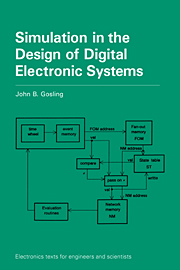Book contents
- Frontmatter
- Contents
- Preface
- 1 An introduction to the simulation of electronic systems
- 2 Electronic computer aided design (ECAD) systems
- 3 Design for testability
- 4 Exercising the design in simulation and test
- 5 Input/output of simulation and specification of models
- 6 Simulation algorithms
- 7 Models and model design
- 8 Timing verification
- 9 Fault simulation
- 10 Simulator features and extensions
- Appendix
- References
- Index
2 - Electronic computer aided design (ECAD) systems
Published online by Cambridge University Press: 05 June 2012
- Frontmatter
- Contents
- Preface
- 1 An introduction to the simulation of electronic systems
- 2 Electronic computer aided design (ECAD) systems
- 3 Design for testability
- 4 Exercising the design in simulation and test
- 5 Input/output of simulation and specification of models
- 6 Simulation algorithms
- 7 Models and model design
- 8 Timing verification
- 9 Fault simulation
- 10 Simulator features and extensions
- Appendix
- References
- Index
Summary
The design process
Designing any piece of equipment (not necessarily electronic) is not a straight path from start through to product, even when no mistakes are made. At each stage problems occur which may require previous decisions to be reviewed. For example, it may be found on simulation that a particular part of the design will not operate fast enough to meet the specification. That part of the design, and possibly others, will have to be reviewed until the criteria are met or proved to be impossible. In the latter case it will be necessary to reconsider the specification. Fig. 2.1 is a summary of the process, and the reader should refer to it from time to time whilst reading the rest of this chapter.
Specification
Every design begins with a customer specification, which describes the function the design is intended to perform. This may include not only the logical properties but the speed of operation, the output power driving capability, the capability of circuits that drive the design, the power supply available, perhaps limits on power dissipation and electromagnetic radiation, operation in the presence of external radiation etc. Sometimes it is difficult to satisfy all the criteria. Higher speeds will require higher power dissipation and faster clocks. The latter increases the electromagnetic radiation. Some criteria may not be important, or only marginally so. With certain pieces of logic the power dissipation may be minimal so that power limits are not important.
- Type
- Chapter
- Information
- Simulation in the Design of Digital Electronic Systems , pp. 20 - 36Publisher: Cambridge University PressPrint publication year: 1993



